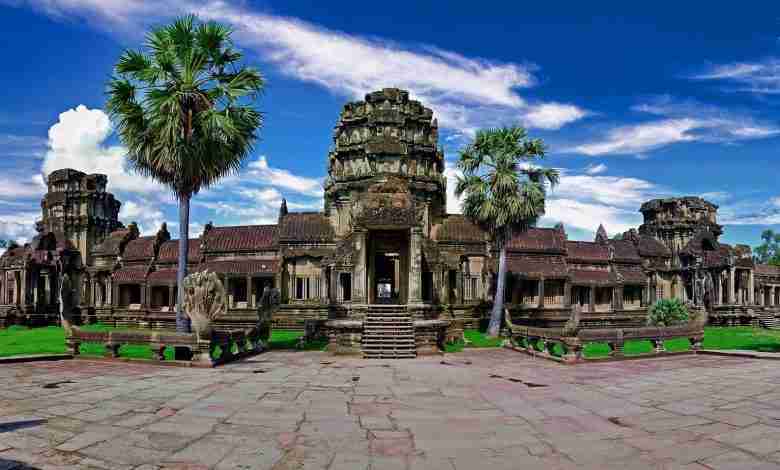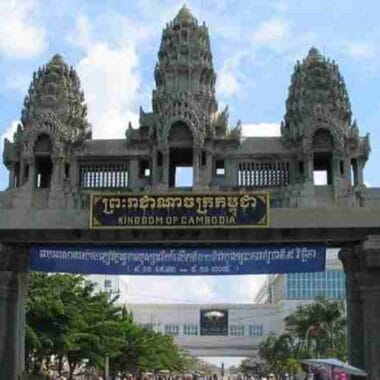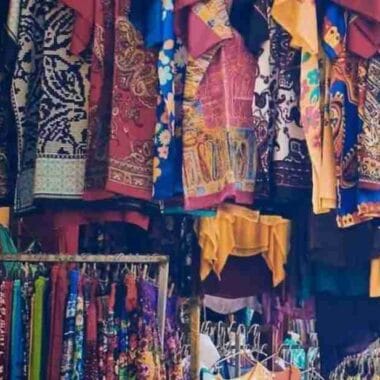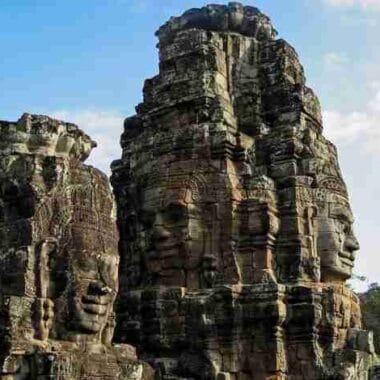Angkor Wat – 7 Wonder Ancient Temple of the World : Angkor Wat known as City Temples is the largest and oldest religious monument in the world. This stunning Hindu temples is one of the “Seven Wonders Of The World” and listed in World surprise List for all visitors must-see and have a opportunity to get a unit experience Hindu and Buddhist cultures within a single landmark. Angkor Wat is part of Angkor Archaeological Park and located about six kilometers north of Siem Reap, south of Angkor Thom. Entry and exit to Angkor Wat can only be access from its west gate.
Angkor Wat was originally constructed as a Hindu temple of god Vishnu for the Khmer Empire, gradually transforming into a Buddhist temple toward the end of the 12th century. Estimated construction time of the temple is 30 years by King Suryavarman II in the first half of the 12th century (113-5BC). The temple is at the top of the high classical style of Khmer architecture. It has become a symbol of Cambodia, appearing on its national flag, and it is the country’s prime attraction for visitors.
Tips for first time travelers to Angkor Wat
- Angkor Pass: All foreigners have to purchase a pass to enter the Angkor park. These can be purchased at the front gate it costs US$37 for one day, US$62 for three days (which can be used over a period of 10 days) and US$72 for one week (which can be used over one month).
- Only purchase Angkor Park passes official Apsara Authority counters – not other vendors, and never second-hand.
- Cambodians enter for free, so your guide or driver will not need a pass. You can enter the park after 5pm to view the sunset without it counting as use of a day on your pass.
- Angkor Wat opens at 5am for visitors who want to see the sunrise from this iconic spot. The upper level (Bakan Sanctuary) is only open from 7.30am. Angkor Wat closes at 5.30pm.
- Guides cost around US$20-25 a day. Guides are available for most major languages. Hiring a guide is a really good idea as there is so much to see; a guide can help make sure you optimize your available time.
- Make sure your clothing is modest as a respect to the local culture.
- The Tuk Tuk or taxi drivers know a good deal about the temples. However, it is advisable to hire a guide at least while visiting the main attractions. There is a lot of history in there which we may not have understood without the guide to explain it to us.
- It’s also easy for you to get daily flight offeres by SiemReap Airways or Air Asia for a cheap opportunity. Let’s go and discover.
- Besides Angkor Wat, the three other “must-sees” temples are the Bayon, Preah Khan and Ta Prohm. The smaller temples, Neak Pean and Ta Som are also worth exploring.
Background
Angkor Wat, the largest monument of the Angkor group and the best preserved, is an architectural masterpiece. Its perfection in composition, balance, proportions, relief’s and sculpture make it one of the finest monuments in the world. Wat is the Khmer name for temple (the French spelling is “vat “), which was probably added to “Angkor “when it became a Theravada Buddhist monument, most likely in the sixteenth century. After 1432 when the capital moved to Phnom Penh, Angkor Wat was cared for by Buddhist monks.
Angkor Architectural Plan
Angkor Wat is a unique combination of the temple mountain (the standard design for the empire’s state temples) and the later plan of concentric galleries. The temple is a representation of Mount Meru, the home of the gods: the central quincunx of towers symbolizes the five peaks of the mountain, and the walls and moat symbolize the surrounding mountain ranges and ocean. The seven-headed naga (mythical serpent) becomes a symbolic rainbow bridge for humankind to reach the abode of the gods.
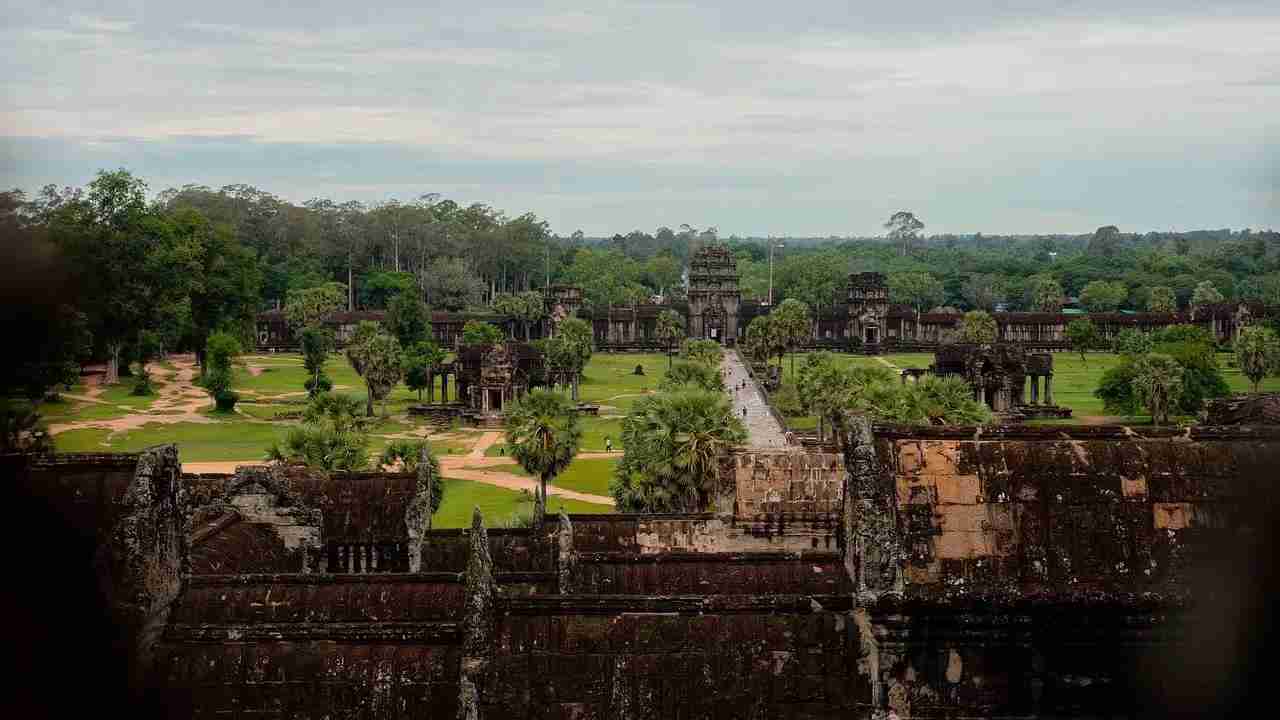
The height of Angkor Wat from the ground to the top of the central tower is greater than it might appear: 213 meters, achieved with three rectangular or square levels. Each one is progressively smaller and higher than the one below starting from the outer limits of the temple. Access to the upper areas of the temple was progressively more exclusive, with the laity being admitted only to the lowest level.
Angkor Wat occupies a rectangular area of about 208 hectares defined by a laetrile wall. The first evidence of the site is a moat with a long sandstone causeway crossing it and serving as the main access to the monument.
The Angkor Wat is builit using two major type of materials, laterite for interior foundation, and sandstone for outer layer which will be used decoration and carving. The massive bricks used to construct the temple of Angkor Wat were brought to the site via a network of hundreds of canals. There are 5 million to 10 million bricks, some weighing up to 1,500 kilograms are used for construction. The sandstone blocks were quarried from the holy mountain of Phnom Kulen, more than 50km away, and floated down the Siem Reap River on rafts. According to inscriptions, the construction of Angkor Wat involved 300,000 workers and 6000 elephants.
The Avenue of west entrance is 475m long and 9.5m wide lined with naga balustrades, steps leading to a raised sandstone terrace in the shape of a cross at the foot of the long causeway. There are giant stone lions on each side of the terrace guard the monument. The inside avenue leading to the central temple, passing between two graceful libraries and then two pools, the northern one a popular spot from which to watch the sun rise.
Western orientation
It is generally accepted that Angkor Wat was a funerary temple for King Suryavarman II. Symbolically, west is the direction of death and oriented to the west to conform to the symbolism between the setting sun and death. Vishnu, however, is also frequently associated with the west, and it is now commonly accepted that Angkor Wat most likely served both as a temple and as a mausoleum for Suryavarman II.
Central complex
The central temple complex consists of three stories, each made of laterite, which enclose a square surrounded by intricately interlinked galleries.
The first and second levels covered with galleries which stretching around the outside of the central temple complex is an 800 meters long series of intricate and astonishing bas-reliefs – carvings depicting historical events and stories from mythology.
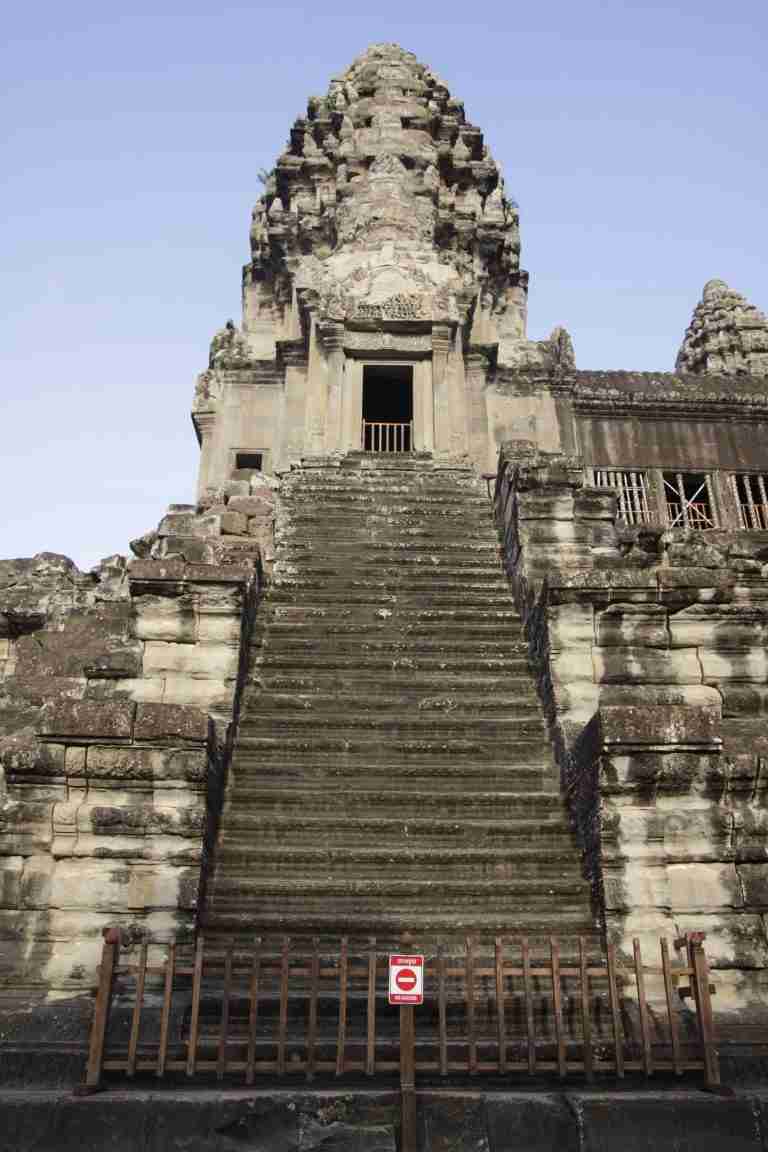
The third level supports five towers, each topped with symbolic lotus-bud towers – four in the corners and one in the middle and these is the most prominent architectural feature of Angkor Wat. The central tower rising 31 meters above the third level and 55 meter above the ground. The stairs to the upper level are immensely steep, and it open to a limited number per day with a queuing system.
Apsara Celestial Nymphs
Angkor Wat is famous for having more than 3000 beguiling Apsaras, a type of female spirit of the clouds and waters in Hindu and Buddhist culture, carved into its walls. Each of them is unique and there are 37 different hairstyles. They figure prominently in the sculpture, dance, literature and painting of many South Asian and Southeast Asian cultures.
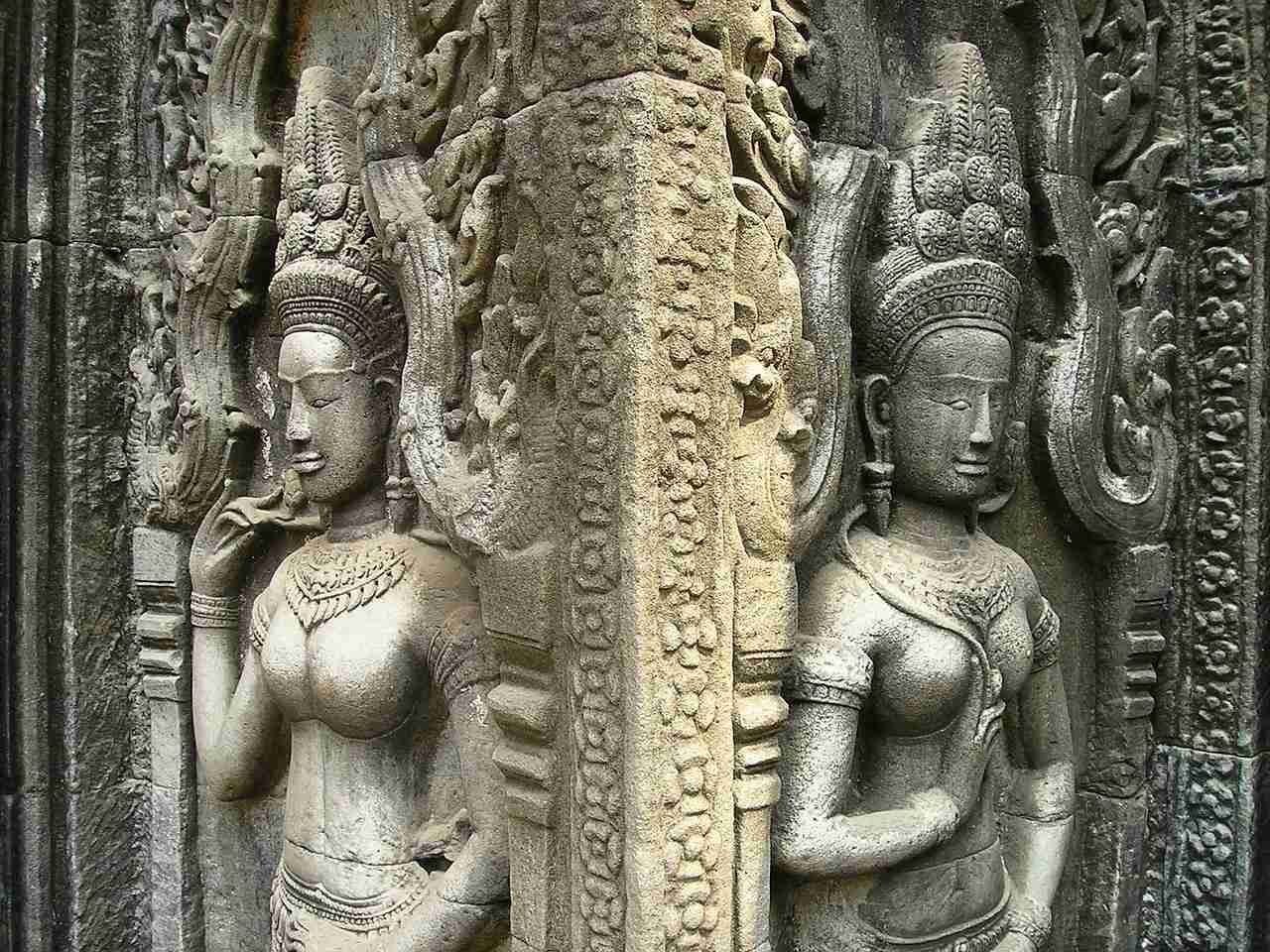
Giant Angkor Wat Moat
Angkor Wat is surrounded by a 190 meter-wide moat, which forms a giant rectangle measuring 1.5km by 1.3km. From the west, a sandstone causeway crosses the moat. Angkor Wat itself is surrounded This moat is 4 meter deep and would have helped stabilize the temple’s foundation, preventing groundwater from rising too high or falling too low. The moat is also formed as second fortification to protect the city, the temple and residents from invasion.
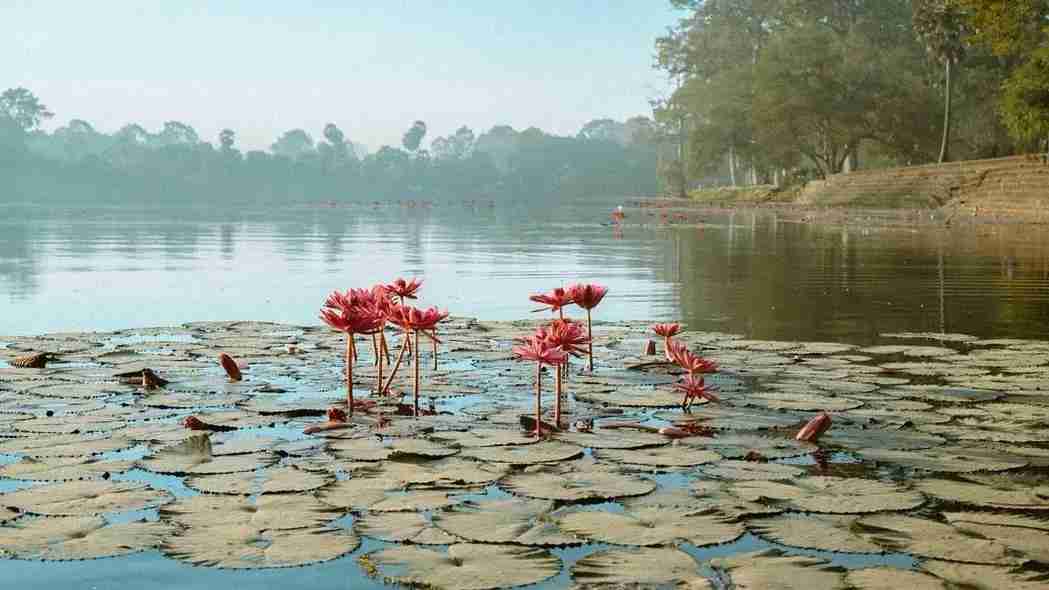
The Great Outer wall Of Angkor
The rectangular outer wall, which measures 1025 meters by 800 meters, has a gate on each side, but the main entrance, a 235 meter-wide porch richly decorated with carvings and sculptures, is on the western side. The outer wall encloses a space of 820,000 square meters (203 acres), which besides the temple proper was originally occupied by the city and, to the north of the temple, the royal palace.
Temple etiquette
As the temples of Angkor represent a sacred religious site to the Khmer people, visitors are asked to dress modestly. It is not possible to visit the highest level of Angkor Wat without upper arms covered and shorts to the knees. Local authorities have visitor ‘code of conduct’ guidelines and a video to encourage appropriate dress, as well as reminding tourists not to touch, sit or climb on the ancient structures, to pay attention to restricted areas, and to be respectful of monks.
What to See at the Angkor Temple
Visiting Cambodia‘s Angkor Wat Temple is like being granted the keys to another world for a short period of time. Angkor Wat consists of five central shrines, encircled by a massive moat and three galleries. The pillars and ceilings of the galleries was decorated with lotus rosettes, apsaras (heavenly nymphs), dancing male figures on prancing animals and motifs of gods, as well as walls showing scenes of legends and ancient combats. Below the 4 Galleries that all visitor must see at Angkor Wat:
West Gallery – Battle of Kurukshetra
This battle scene is the main subject of the Hindu epic Mahabharata. It recalls the historic was wars in Kurukshetra, a province in India, and depicts the last battle between rival enemies who are cousins. The armies of the Kauravas and the Pandavas march from opposite ends towards the center of the panel where they meet in combat. Headpieces differentiate the warriors of the two armies. The scene begins with infantry marching into battle and musicians playing a rhythmic cadence. The battlefield is the scene of hand-to-hand combat and many dead soldiers.
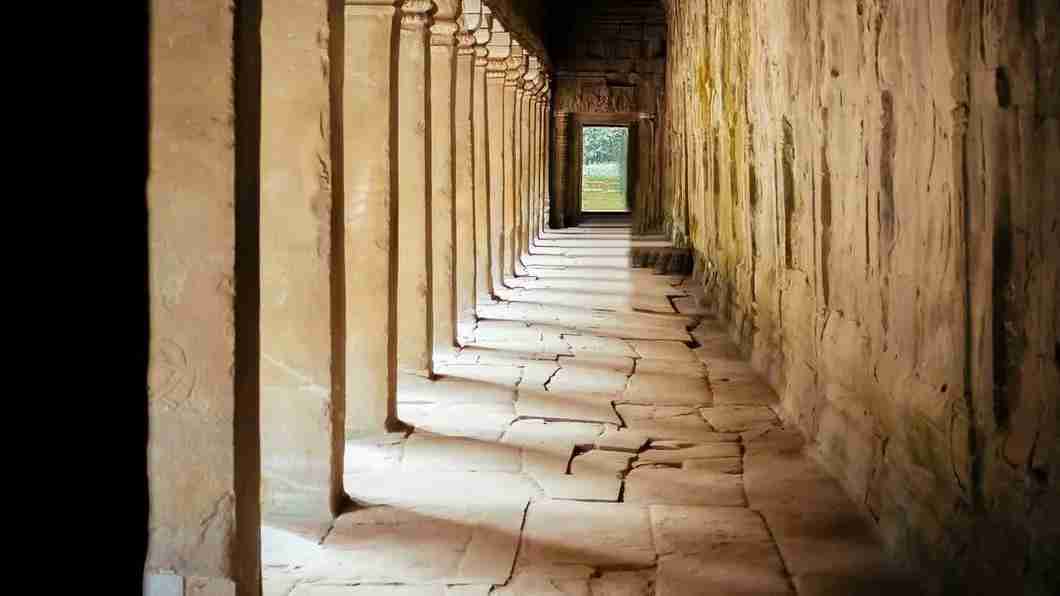
Chief officers and generals (represented on a larger scale) oversee the battle in chariots and on elephants and horses. The scene builds up gradually and climaxes in a melée. Bisma (near the beginning of the pane), one of the heroes of the Mahabharata and commander of the Kauravas, pierced with arrow, is dying and his men surround him. Arjuna (holding a shield decorated with the face of the demon rahu) shoots an arrow at Krsna, his half-brother, and kills him. After death, Krisna (four arms) becomes the charioteer of Arjuna.
South Gallery – Army of King Soryavaman II
This gallery depicts a splendid triumphal procession from a battle between the Khmers and their enemies. The relief’s show methods used in warfare, mainly hand-to-hand combat, as they no machinery and no knowledge of firearms.
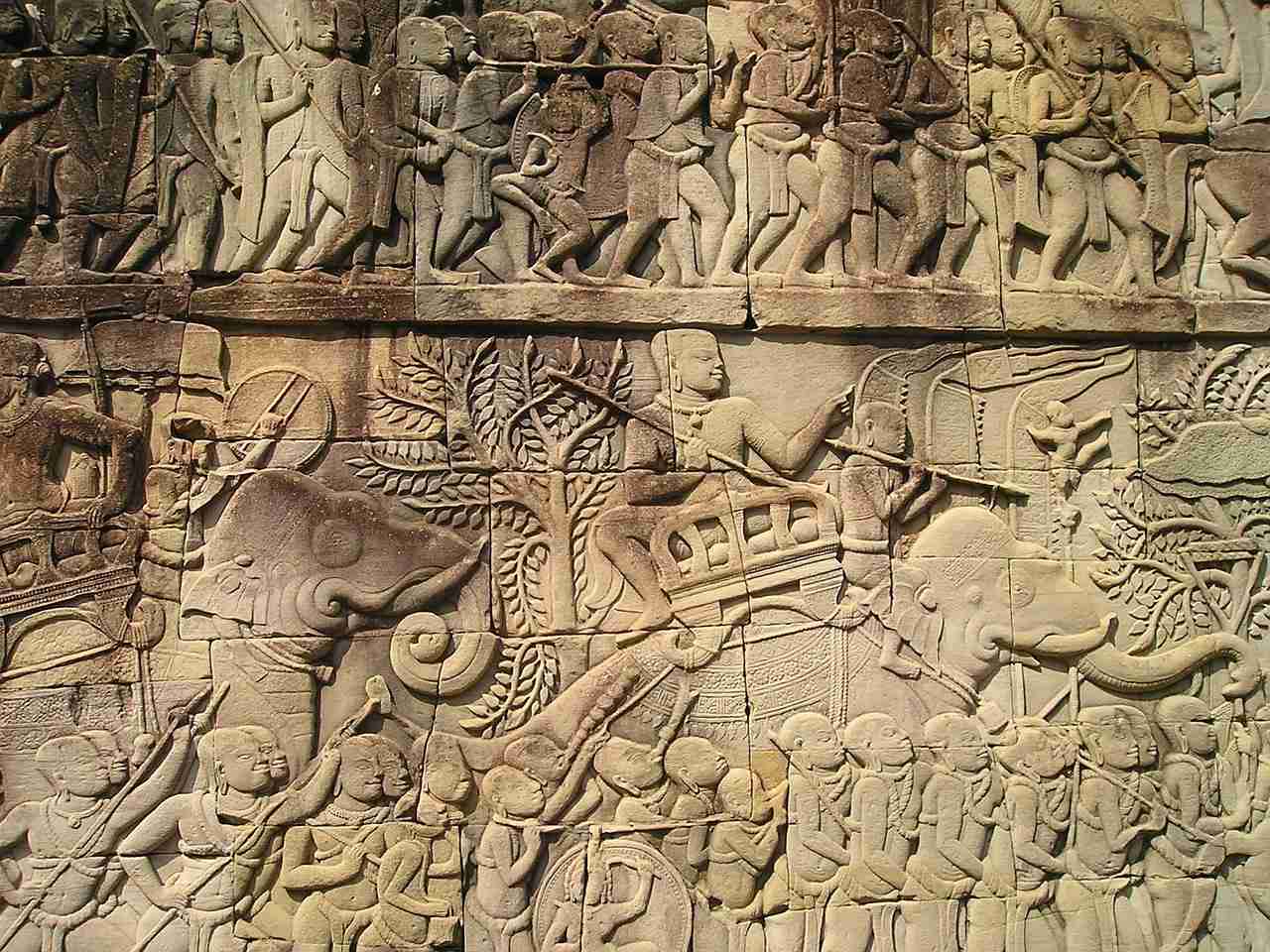
The naturalistic depiction of trees and animals in the background of this panel is unusual. The central figure of this gallery is King Suryavarman II, the builder of Angkor Wat, who appears twice. An inscription on the panel identifies him by his posthumous name, suggesting it may have been done after his death. The rectangular holes randomly cut n this gallery may have contained precious objects of the temple. On the upper tier the king (seated with traces of gilt on his body) holds an audience on a mountain. Below of the place walk down a mountain in the forest.
The army gathers for inspection and the commander mounted on elephants join their troops who are marching towards the enemy. The commander’s rank is identified by a small inscription near the figure. King Suryavarman II stands on an elephant (conical headdress, sword with the blade across his shoulder) and servants around him hold 15 ceremonial umbrellas. Visnu stands on a Garuda on a Garuda on a flagpole in front of the king’s elephant. The lively and loud procession of the Sacred Fire (carried in an ark) follows with standard bearers, musicians and jesters. Brahmans chant to the accompaniment of cymbals. The royal sacrifice in a palanquin.
Towards the end of the panel: The military procession resumes with a troop of Thai soldiers (pleated skirts with floral pattern; belts with long pendants; plaited hair; headdresses with plumes; short moustaches) led by their commander who is mounted on an elephant. The Thai troops were probably either mercenaries of a contingent from the province of Louvo (today called Lopburi) conscripted to the Khmer army. A number of the Khmer warriors wear helmets with horns of animal heads (deer, horse, bird) and some of their shields are embellished with monsters for the same purpose.
East Gallery – Churing of the Ocean of Milk
This is the most famous panel of bas-reliefs at Angkor Wat and derives from the Indian epic Bagavata-Pourana. The Ocean of Milk is churned by gods and demons to generate Amrta, the elixir of life. the purpose of the churning is to recover lost treasures such as the sourer of immortality, Laksmi the goddess of good fortune, the milk white elephant of Indra, and the nymph of loveliness. The retrieval of these objects symbolizes prosperity. It takes place during the second ascent of Visnu, when he is incarnated as a tortoise.
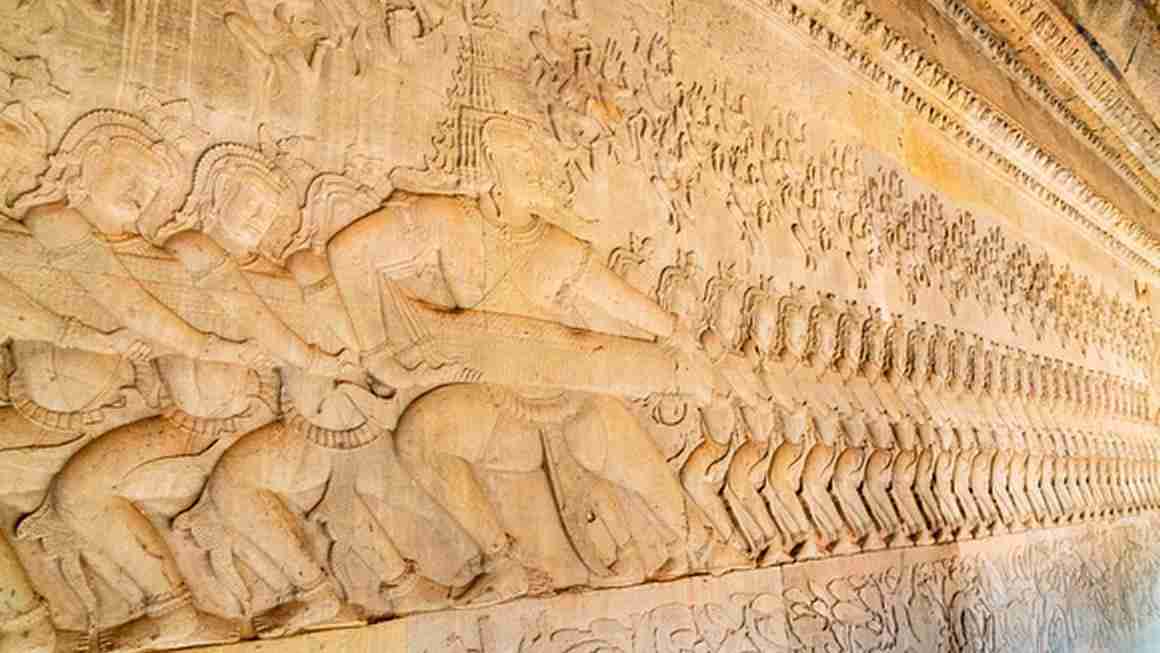
The scene is decided into three tiers. The lower tier comprises various aquatic animals, real and mythical, and is bordered by a serpent. The middle tier has, on one side, a row of 92 demons (round bulging eyes, crested helmets) and, on the other side, a row of 88 gods (almond-shaped eyes, conical headdresses). They work together by holding and churning the serpent. Hanuman, the monkey god, assists. Visnu, in his reincarnation as a tortoise, offers the back of his shell as a base for the mountain Mandara, and as a pivot for the churning. He sits on the bottom of the Ocean. A huge cord in the form of the body of the serpent Vasuki acts as a stirring instrument to churn the sea.
To begin the motion the gods and demons twist the serpent’s body; the demons hold the head and the gods hold the tail of the serpent. Then by pulling it rhythmically back and for th they cause the pivot to rotate and churn the water.
The gods and demons are directed by three persons (identified by their larger size). Indra is on top of Visnu. On the extreme right Hanuman, ally of the gods, tickles the serpent. Upper tier: During the churning various female spirits emerge. Visnu appears in this scene again in yet another reincarnation-as a human being-to preside over the “churning “which, according to legend, lasted more than 1,000 years.
Numerous other beings are depicted such as the three-headed elephant mount of Indra, Apsaras and Laksmmi, the goddess of beauty. They churning provoke the serpent to vomit the mortal venom, which covers the waves. Afraid the venom may destroy the gods and demons, Brahma intervenes and requests Siva to devour and drink the venom, which will leave an indelible trace on Siva’s throat. He complies and, as a result, he Amtrak pours forth. The demon rush to capture all the liquid. Visnu hurries to the rescue and assumes yet another reincarnation in the form of Maya, a bewitching beauty, and is able to restore much of the coveted liquid.
North Gallery
Victory of Krisna over Bana the Demon King
At the beginning of the panel Visnu in his incarnation as Krsna (framed by two heroes) sits on the shoulders of a Gruda. Agni, the god of Fire (multiple arms), sits on a rhinoceros behind him. This scene appears several times. A wall surrounding the city is on fire and prevents the advance of Krsna (mounted of a Garuda) and his army of gods. This Krsna scene also appears several times in the panel. The Garuda extinguishes the fire with water from the sacred river Ganges. The demon Bana (multiple arms, mounted on a rhinoceros) approaches from the opposite direction. Extreme right: Krsna (1,000 heads, hands across his chest) kneels in front of Siva who sits enthroned on Mount Kailasa with his wife Parvati and their son ganesa (head of an elephant) as they demand that Siva spare the life of Bana.

A procession of 21 gods of the Brahmanic pantheon march in procession carrying classic attributes and riding traditional mounts. One-god battles against a demon while warriors on both sides battle in the background. A series of adversaries follow, the Kubera, God of riches (with bow and arrow), Appears on the shoulders of a Yaksa; followed by Skanda, Goe of war (multiple heads and arms), mounded on a peacock; Indra stands on his mount the elephant; Visnu (four arms) sits on his mount, a Guard; a demon (tiered heads) shaking swords; Yama, God of Death and. Justice (sword and shield), stands in a chariot pulled by horses; and Varian, God of the Water, stands on a five-headed serpent harnessed like a beast of burden.
How to get to Angkor Wat temple
The fast-growing town of Siem Reap is the gateway to Angkor and is filled with lodging, dining, and tour-package options for all budgets and inclinations. Siem Reap can be reached via good roads from Phnom Penh and buses and taxis make the trip regularly. Those preferring to travel by boat can also make the trip from Phnom Penh in some five or six hours—about the same travel time as by road. The airport in Siem Reap has service to Phnom Penh and regular flights abroad to Thailand, Singapore, Vietnam, and Laos.
When to Go Angkor Wat in Cambodia
It is possible to visit Angkor Wat at any time of year, but the best time to visit Angkor Wat is between November to March. You can expect cool, dry days. Angkor Wat is less crowded between June to October, but be prepared for hot and potentially wet weather. The best time of day is sunrise when it’s cooler but crowded, or lunchtime when most of the tour groups are in town. One day is enough to explore the whole Angkor Wat complex, but you need at list three or four days to explore all the major sights in Siem Reap.
